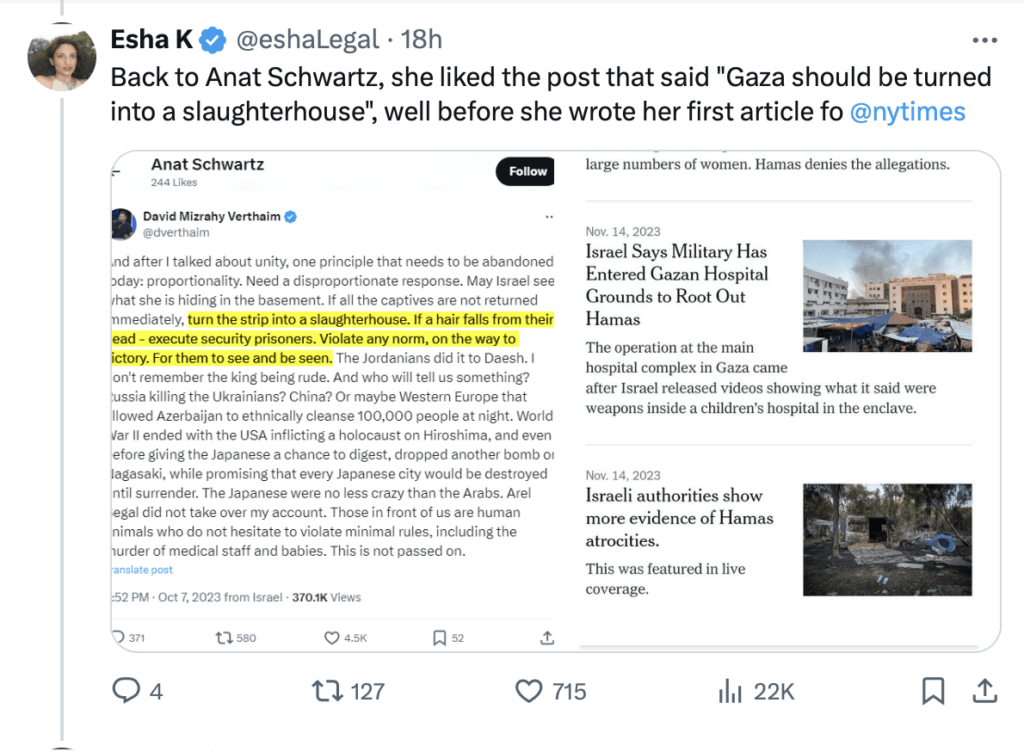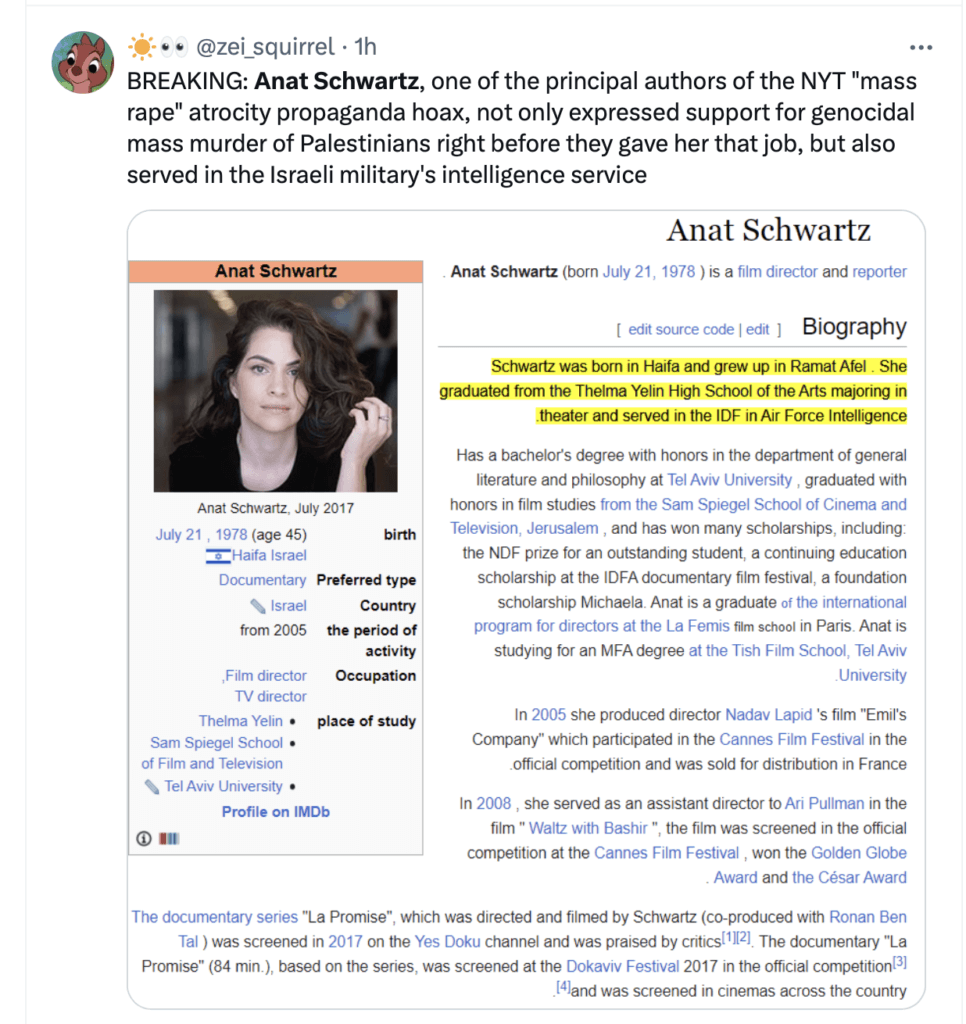New York Times ‘Reviewing’ Reporter Who Liked Gaza ‘Slaughterhouse’ Tweet
The likes on X included a tweet calling for Israel to turn the Gaza Strip into a “slaughterhouse.”

Mario Tama/Getty
The New York Times is investigating Israeli freelancer Anat Schwartz after she repeatedly liked multiple X posts that indicated a pro-Israel bias, including one that called for the Gaza Strip to be turned into a “slaughterhouse.”
“We are aware that a freelance journalist in Israel who has worked with The Times has ‘liked’ several social media posts,” Times spokesperson Danielle Rhodes Ha said in a statement. “Those ‘likes’ are unacceptable violations of our company policy. We are currently reviewing the matter.”
Schwartz began reporting for the Times in November, where her stories focused on Israel’s response to the Oct. 7 attacks. Her most prominent piece was a co-bylined article detailing sexual violence allegedly committed by Hamas during the raids. The story had drawn internal criticism from staffers and led the Times to pull an episode of The Daily podcast on the original story, according to The Intercept.
The statement came after an X user found that Schwartz liked various X posts that had a pro-Israel slant, such as a tweet from Israel’s official X account that claimed Hamas beheaded dozens of babies during its Oct. 7 attack. Israel has provided no evidence for the claim and has saidinvestigating it would be “disrespectful to the dead.”
Her most egregious “like” came from a post by David Verthaim, who wrote shortly after the Oct. 7 attacks that should Hamas not return the hostages to Israel, Israel should turn the Gaza Strip “into a slaughterhouse,” according to an autotranslation of his Hebrew post. Verthaim also advocated for Israel to “violate any norm, on the way to victory.”
The New York Times’ social media policy warns journalists that all posts and likes “must not express partisan opinions, promote political views, endorse candidates, make offensive comments or do anything else that undercuts The Times’s journalistic reputation.” Users on X noticed on Saturday that Schwartz had briefly deactivated her account to remove the “likes.”
Schwartz did not immediately respond to a request for comment. Her LinkedIn page lists her current role as a director and screenwriter at KAN, an Israeli state-owned media outlet.
Extraordinary charges of bias emerge against NYTimes reporter Anat Schwartz

New doubts are emerging about the New York Times’s coverage of sexual violence during the October 7 Hamas-led attack — and the paper owes its readers an open and transparent explanation.
What’s more, its reporting on this issue has become so questionable that it should assign new reporters to go over the entire story again.
The latest questions are centered around Anat Schwartz, an Israeli who co-authored several of the paper’s most widely circulated reports, including the now well-known and scrutinized December 28 article headlined: “‘Screams Without Words’’ How Hamas Weaponized Sexual Violence on Oct. 7.”
Independent researchers scrutinized the online record, and raised serious questions about Schwartz. First, she has apparently never been a reporter but is actually a filmmaker, who the Times suddenly hired in October. You would expect the paper to look for someone with actual journalistic experience, especially for a story as sensitive as this one, written during the fog of war. Surely the paper had enough of its own correspondents on staff who could have been assigned to it.
Next, the researchers found that Schwartz had not hidden her strong feelings online. There are screenshots of her “liking” certain posts that repeated the “40 beheaded baby” hoax, and that endorsed another hysterical post that urged the Israeli army to “turn Gaza into a slaughterhouse,” and called Palestinians “human animals.”

(Just this morning, more evidence emerged online; Schwartz apparently also served in Israeli Military Intelligence.)

Finally, one of her co-authors on two of the reports was Adam Sella, who is her nephew.
Let’s pause here. What would happen if the Times suddenly hired a Palestinian filmmaker with no journalistic background, who had recently publicly “liked” posts that called for “pushing Israeli Jews into the sea,” to co-write several of its most sensitive and contested reports?
(We don’t have to speculate. The Times fired Palestinian photojournalist Hosam Salam in 2022 after one of the pro-Israel media watchdog groups protested about his social media posts.)
After Anat Schwartz’s online history became public, she locked down her accounts and then deleted much of the incriminating content.
The New York Times imposes strict rules on its reporters to maintain the appearance of objectivity. Reporters are not supposed to attend demonstrations of any kind, wear campaign buttons, or post opinions on social media. By hiring Anat Schwartz, the paper clearly violated its own guidelines, and it should publicly explain and apologize.
There’s another related example of how the Times has botched the sexual violence story. One of the first Israeli organizations that arrived on the scene of the Hamas attack was Zaka, a volunteer group that recovers dead bodies. On January 15, Timesreporter Sheena Frankel wrote a positive profile of the group; she included 3 or 4 sentences of criticism, only to quickly dismiss them. This site had already raised serious doubts about Zaka weeks earlier, pointing out that “the organization’s volunteers have systematically given false testimonies, and continue repeating them to journalists on behalf of the Israel government.” Then, on January 31, the Israeli daily Haaretz published a long investigation, that highlighted “cases of negligence, misinformation and a fundraising campaign that used the dead as props.” Haaretz cited one Zaka report that said a volunteer had seen a murdered pregnant woman, with the baby still attached by the umbilical cord — before concluding that the incident “simply didn’t happen.”
At this stage, there are serious doubts about many aspects of Israel’s overall account about October 7. Only a genuinely independent and impartial investigation might some day get closer to the truth. But meanwhile, at the very least the New York Times must publicly recognize its errors, and assign new, unbiased reporters to try to clean up its mess.






Geen opmerkingen:
Een reactie posten